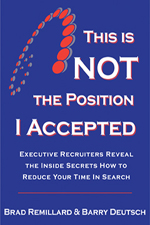Cover Letter + Great Resume = Interview
This is the winning formula for getting interviews. There are exceptions for personal referrals and networking contacts, but often even with these they will first ask for a resume.
It has been my experience recently that many candidates “know” this formula intellectually but few convert from the knowing to “doing.” And that after all is the key.
I’m currently conducting a search and as one might expect the number of resumes received is almost overwhelming. I spend my weekends and nights just trying to empty my inbox. Not an easy task. About 65% of the resumes I receive have cover letters. Most to some varying degree give me the standard, BLAH, BLAH, BLAH. Once in a while one will stand out so I take the time to read it. I particularly like the two column format as it quickly aligns their experiences with what I’m seeking for my client. (If you want to get an example, a free sample is available, just CLICK HERE).
These types of cover letters can get me very excited to actually read (not scan) your resume. The problem is too often the rug is pulled right out from under my high level of excitement. Simply put the resume sucks. There are many reasons for this, but regardless, this person had me and other recruiters, hiring managers and HR professionals right where they want them. They overcame one of the biggest issues with resumes, getting the resume read not just a 10 second scan. Only to disappoint the reader. What a tragedy.
In this example the formula was: great cover letter + average or below average resume = trashed resume.
Anyone who has been following Barry and I know we have written extensively that in this economy it is greatness that counts. Good only works in good times. Greatness works all the time, but is positively, absolutely, a must in bad times.
A great cover letter with an average or below average resume, is like a bad book with a great dust cover. It is still a bad book. How many times have you sat in a movie theater watching an upcoming movie trailer, then gone to the movie and it was really bad? Remember the excitement about waiting for the movie to come out, the excitement as you sat waiting for the movie to start, and then the disappointment when the movie was so bad you walked out. A great movie trailer doesn’t make a bad movie better.
A great resume starts with understanding how a resume is scanned. Start with the basics:
- Your contact information including a phone number. Sounds pretty basic to me. For some reason many candidates are starting to have only an email address on the resume.
- Basic information about the companies you worked for (unless they are household names), such as sales, number of employees, and what the company does or the industry.
- Basic information regarding the scope of your positions. Number of people supervised, basic duties and responsibilities, if multi-location, international, functional area managed, etc.
- Education. When appropriate additional certifications or courses that enhance your marketability.
- Company ownership. Is it a public company, owner operated, private equity owned or something else?
- Some bullet points that directly align as closely as possible to the two column cover letter you included.
- Bullet points that include results in dollars or percentages as to the impact on the department or company.
These are basics. There are more that will get your resume from good to great. At least review your resume to verify you have met the minimum.
Join our Linkedin Job Search Networking Group. Over 3200 members. CLICK HERE to join.
Download a free sample cover letter – that is the first step. You still need a great resume. CLICK HERE to get the FREE cover letter.






